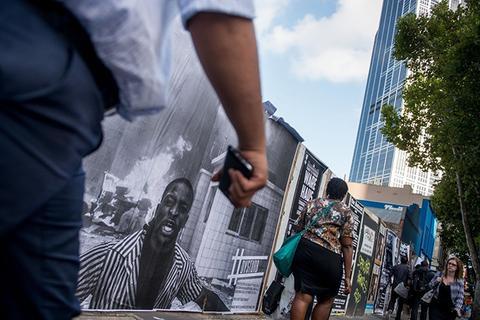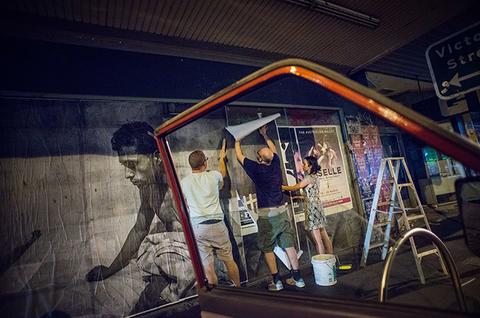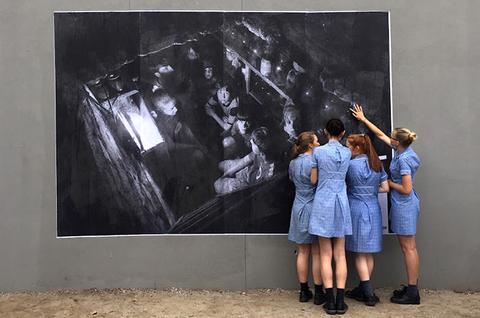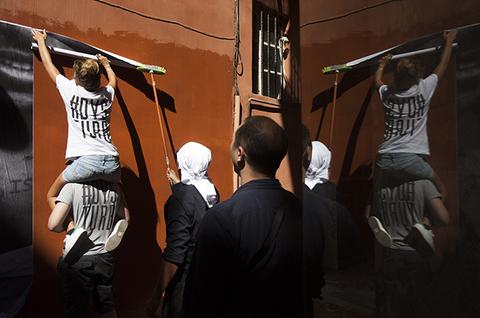#Dysturb
Street artists #Dysturb visited Sydney for the first time 17-20 July 2015. While they’re here #Dysturb gave a free public talk (see link below), presented a workshop with ACP and pasted up works at four locations across inner Sydney.
- Australian Centre for Photography, Oxford St, Paddington
- Not Just Coffee, Perry Lane, Paddington
- Newtown Neighbourhood Centre, Newtown
- University of Technology, Bon Marche Studio Entrance on Harris St, Ultimo
Finding exciting new ways to show photojournalism, international group #Dysturb is a collective that combines photojournalism and street art to bring world news to a bigger audience. Co-founded by French photojournalists Pierre Terdjman and Benjamin Girette in March 2014, the group paste up large-scale black and white photographs with captions on busy city streets all over the world. They have the privilege of showing the work of major photojournalists, including Paolo Pelligrin, Ashley Gilbertson and Moises Saman. Since their beginnings #Dysturb have been involved with Magnum Foundation and Getty Images, and this month they have been working with Sarajevo’s WARM festival.
Antoinette Clements chatted with #Dysturb’s founders Pierre and Benjamin to get an insight into their aims, achievements and plans for the future.
AC: We are really looking forward to collaborating with #Dysturb in Sydney next week and thank you so much for taking the time to answer a few questions.
To begin with, tell us how and why did #Dysturb form?
PT: In 2014, I returned from Central African Republic (CAR) and I was determined to give my stories the voice, and visibility, that they deserved.
As I am sure you are aware, an increasing number of media organisations are hiring photographers to cover conflict zones, or places of unrest, and this has resulted in freelance photographers taking greater risks to tell stories from these places. Essentially, #Dysturb was born out of this concern and it has now evolved into a support network for freelancers and agency photographers.
BG: Our focus is to give a voice to these images that have been caught up in the disposability of the news media cycle. These events that we photograph are in fact shaping the world that we live in, and it is important to be aware of them.
AC: Tell us a bit about the motivations of your urban interventions. What is the focus of #Dysturb? Do you see your paste-ups as a form of activism or education? And is there a political or cultural agenda behind the project?
For us, these paste-ups are more about education. In some ways, we are inadvertently challenging the lack of support photojournalists, especially freelancers, have. However, at the same time, this is overwhelmed by our desire to initiate others’ knowledge regarding the world. There is no political or cultural agenda behind this project – we only paste international news within cities.
AC: #Dysturb works across physical and online platforms, cutting out the middleman and providing editorial control of content.
How do you determine which images are selected and does location play a role?
PT: It is a time-consuming process. Location definitely plays a role, along with the nationality of those who inhabit certain areas of cities, as well as what that particular area of a city is known for. For example, recently we placed a Lisa Krantz image in Soho, which shows a shirtless, young, obese man having his hair cut by his mother. This was juxtaposed with advertising in the area that highlights waif-like models, wearing the latest fashionable attire.
AC: All of #Dysturb’s paste-up’s include captions providing the context for the image. Why are both aspects necessary for the viewer?
BG: Contextualising an image is crucial if one is to fully understand what one is are viewing. The viewer plays two roles, one to view the image and then understand the image.
AC: What is your philosophy on the role of imagery in community engagement?
PT: Images are informative, helping one to make sense of the world in which we live, and yet at the same time, they can evoke emotion. These two qualities are powerful, and this is what drives community engagement – particularly because the act of taking an image has become an experience that ripples into the eye of the viewer.
AC: #Dysturb is filling a gap in the dissemination of world news through photojournalism. Pierre, you have said of #Dysturb “The street is the ultimate social network…You’re reaching everyone.”
How do you see this reach as significant when compared to the distribution of information through online channels?
BG: We have placed photojournalism in public spaces, and this means that it can be stumbled upon.
This information is free to the general public, and the reason it is free is because we believe it is every citizen’s right to be informed, and not be deterred by the cloud of mistrust that has blanketed news media organisations.
Curiosity is a powerful desire, and it is our hope that these images do ignite the general population’s curiosity about international events. Essentially, these events are shaping the world in which we all live, and it is our duty to understand and know, because these events are part of our history.
AC: The streets have become the gallery for your work. Would you ever consider shifting to more traditional formats, an exhibition or photobook?
BG: The street is an important platform for us. So for now, we are focusing on this and collaborating with educational facilities.
AC: With that in mind, does the materiality of the image add to its power?
PT: It does. We disseminate our images to online audiences as well as the “physical audience”. The reason why we use the streets is because it is a physical image, and it is part of the experience of the image.
It’s fascinating, and remarkable in some ways. When we paste photojournalism in schools, students want to hold and touch the image. It’s moving, and also part of the experience of the image.
AC: #Dysturb is a community of photographers and bill stickers located all over the world. How have photographers and the community gotten involved and how can others get on board?
PT: At the moment, it has been mostly people who we know or that people recommended to us, and trust. However, in saying that, we are open to others’ ideas.
Currently, we are working on a new website that will aid in involving people in a more global and communal way.
AC: Have you seen an impact in the cities you have worked in?
PT: Yes, we have. Cities have promoted our work, and their networks have shared, and discussed our project. Cities where we have pasted images have asked us to return on a regular basis, and this is also the case for educational facilities that we have collaborated with. The general reaction is overwhelming and that pushes us to go forward.
AC: This project is still relatively young, how would you like to see the work and community engagement grow as you continue? Do you have any new projects on the horizon?
BG: We see #Dysturb growing in such a way that it supports the photojournalists with whom we collaborate. We also envision increased collaborations with educational facilities, and universities.
PT: For us, we aim that the project, and indeed community engagement, will increase so much so, that we will have a much larger network of photojournalists with whom to collaborate with.
We are also currently working on interviews with photojournalists who have, in the past, donated their images to us. This will add another layer of context to the imagery. We are also looking to new, innovative ways of broadcasting the work, and engaging the audience in a more direct and interactive way.
About Pierre Terdjman and Benjamin Girette
Pierre Terdjmanhas been embedded with the French armed forces in Afghanistan, and has covered the Arab revolution in Tunisia, Egypt and Libya, as well as the Russia-Georgia conflict, the earthquake in Haiti, and postelection violence in Kenya. In 2012, he won the Photoreporter Festival of Saint-Brieuc scholarship to continue his work in the long term. In 2013, he covered the uprising of violence’s in Central Africa for the French magazine Paris Match. Earlier this year, he won the Lens Culture Award for a picture from his work in Central African Republic. His photographs are regularly published in Paris Match, GQ and The New York Times Magazine. In April 2015, Pierre joined Getty Images Reportage.
Benjamin Girette is a Paris-based photojournalist with IP3 Press agency. He has covered stories ranging from notional French stories to illegal immigration in Italy, the ‘Indignados’ movement in Spain, the fall of President Ben Ali in Tunisia, as well as Hosni Mubarak and Mohamed Morsi in Egypt and most recently he has covered the conflict in Kiev, Ukraine. He has been published internationally.
Resources
Listen to #Dysturb’s Tamara Voninski and Madelena Rehorek in conversation with award winning journalist Helen Vatsikopoulos at UTS on 17 July 2015. here
The talk was followed by a demonstration of a #Dysturb’s paste-up on the UTS campus, in which the audience are invited to participate here
Public Program
18 July 2015, ACP held a workshop with #Dysturb collaborators Tamara Voninski (founding member of Oculi) and Madelena Rehorek (director of Ruffian Gallery, Melbourne)
Images
1: 16 February 2015. Melbourne, Australia. An image taken by Théo Renaut was placed on the corner of Elizabeth St & A’Bbeckett St, in Melbourne’s City Centre. The caption reads: October 28, 2014. Protestors gather at Place de la Nation in Ouagadougou, the capital of Burkina Faso. © Benjamin Girette/ #Dysturb
2: #Dysturb Official
3: Pictured is Philippe de Poulpiquet’s photograph for Le Parisien, which #Dysturb pasted in Perpignan for Visa pour l’image (@visapourlimage).Caption reads: 16 July 2014. Gaza. Family and relatives of the four boys killed on the beach in Gaza mourn in front of the family house before the funerals of the four boys. Four Palestinian boys have been killed by an Israeli shelling while they were playing next to a fisherman house on the beach. Four other kids have also been wounded. Photo by Capucine Bailly (@capbailly)
4: Pictured is an image of Olivier Jobard’s (M.Y.O.P), which was pasted in Melbourne, Australia for the PhotoBook Melbourne Festival (@photobookmelbourne). The caption reads: 4 January 2015. Calais, France. A makeshift migrant camp at a Tioxide plant. Several hundreds of migrants from Eritrea and Sudan live in extreme precarity, in hopes that they will go to England. Photo by Benjamin Petit (@bendophoto)
5: #Dysturb team pastes an image at Visa pour l’image (@visapourlimage) in Perpignan.
6: 23 February 2015. McKinnon Secondary College, in Melbourne, Australia. #Dysturb spoke with McKinnon students about the power of photojournalism and the changing media landscape. Pictured is an image by Andy Rocchelli that McKinnon students helped to paste in the school. The caption reads: Ukraine, Sloviansk, Cherevkovka District. A family hides from the bombardment in the cellar. © Pierre Terdjman/ #Dysturb
7: 14 February 2015. Melbourne, Australia. Tomas van Houtryve/ VII’s image was pasted at Ruffian Gallery. The caption reads: Students are seen in a schoolyard in El Dorado County, California. In 2006, a drone strike on a religious school in the village of Chenegai reportedly killed up to 69 Pakistani children. © Benjamin Girette/ #Dysturb
8: 15 February 2015. Melbourne, Australia. An image by Adrienne Surprenant/ Hans Lucas was pasted at 423 Sydney Rd, Brunswick. The caption reads: 24 December 2014. Nicaragua. In El Tule, Nicaragua, a 23‐year‐old man was hurt by a bullet in the morning of 24 December 2014. He was protesting against the interoceanic canal project led by a Hong Kong enterprise, and the Sandinista government. The project will displace 29, 000 people, mainly farmers like him. © Benjamin Girette/ #Dysturb
 16 February 2015. Melbourne, Australia. An image taken by Théo Renaut was placed on the corner of Elizabeth St & A’Bbeckett St, in Melbourne’s City Centre. The caption reads: October 28, 2014. Protestors gather at Place de la Nation in Ouagadougou, the capital of Burkina Faso. © Benjamin Girette/ #Dysturb
16 February 2015. Melbourne, Australia. An image taken by Théo Renaut was placed on the corner of Elizabeth St & A’Bbeckett St, in Melbourne’s City Centre. The caption reads: October 28, 2014. Protestors gather at Place de la Nation in Ouagadougou, the capital of Burkina Faso. © Benjamin Girette/ #Dysturb An image by Adrienne Surprenant/ Hans Lucas was pasted at 423 Sydney Rd, Brunswick. The caption reads: December 24, 2014. Nicaragua. In El Tule, Nicaragua, a 23-year-old man was hurt by a bullet in the morning of the 24th of December 2014. He was protesting against the interoceanic canal project led by a Hong Kong enterprise, and the Sandinista government. The project will displace 29, 000 people, mainly farmers like him.
An image by Adrienne Surprenant/ Hans Lucas was pasted at 423 Sydney Rd, Brunswick. The caption reads: December 24, 2014. Nicaragua. In El Tule, Nicaragua, a 23-year-old man was hurt by a bullet in the morning of the 24th of December 2014. He was protesting against the interoceanic canal project led by a Hong Kong enterprise, and the Sandinista government. The project will displace 29, 000 people, mainly farmers like him. Tomas van Houtryve/ VII’s image pasted at Ruffian Gallery. The caption reads: Students are seen in a schoolyard in El Dorado County, California. In 2006, a drone strike on a religious school in the village of Chenegai reportedly killed up to 69 Pakistani children.
Tomas van Houtryve/ VII’s image pasted at Ruffian Gallery. The caption reads: Students are seen in a schoolyard in El Dorado County, California. In 2006, a drone strike on a religious school in the village of Chenegai reportedly killed up to 69 Pakistani children. McKinnon Secondary College, in Melbourne, Australia. Here we spoke with students about the power of photojournalism and the changing media landscape.Pictured is an image by Andy Rocchelli that McKinnon students helped to paste in the school. The caption reads: Ukraine, Sloviansk, Cherevkovka District. A family hides from the bombardment in the cellar.
McKinnon Secondary College, in Melbourne, Australia. Here we spoke with students about the power of photojournalism and the changing media landscape.Pictured is an image by Andy Rocchelli that McKinnon students helped to paste in the school. The caption reads: Ukraine, Sloviansk, Cherevkovka District. A family hides from the bombardment in the cellar. Perpignan, France. August 31st 2014. #DYSTURB @ Visa Pour L’image. #Dysturb team pastes an image at Visa pour l’image (@visapourlimage) in Perpignan.
Perpignan, France. August 31st 2014. #DYSTURB @ Visa Pour L’image. #Dysturb team pastes an image at Visa pour l’image (@visapourlimage) in Perpignan. Pictured is an image of Olivier Jobard’s (M.Y.O.P), which was pasted in Melbourne, Australia for the PhotoBook Melbourne Festival (@photobookmelbourne). The caption reads: 4 January 2015. Calais, France. A makeshift migrant camp at a Tioxide plant. Several hundreds of migrants from Eritrea and Sudan live in extreme precarity, in hopes that they will go to England. Photo by Benjamin Petit (@bendophoto)
Pictured is an image of Olivier Jobard’s (M.Y.O.P), which was pasted in Melbourne, Australia for the PhotoBook Melbourne Festival (@photobookmelbourne). The caption reads: 4 January 2015. Calais, France. A makeshift migrant camp at a Tioxide plant. Several hundreds of migrants from Eritrea and Sudan live in extreme precarity, in hopes that they will go to England. Photo by Benjamin Petit (@bendophoto)



